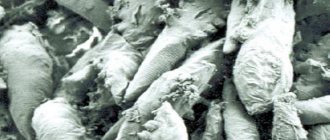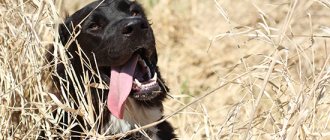Heart failure - what is it?
Heart failure in dogs is a condition in which the heart loses its ability to pump enough blood and can no longer meet the body's oxygen needs. The result is a decrease in the intensity of blood circulation, a slowdown in metabolic processes and disruption of the functioning of internal organs.
Some dog breeds are predisposed to this disease, so their owners need to be especially careful. Among them:
- collie,
- shepherd,
- English bulldog,
- schnauzer,
- boxer,
- spaniel,
- fox terrier.
Treatment of chronic heart failure in dogs
The method of treating the animal depends on the underlying disease as a result of which heart failure developed. Usually it is impossible to completely eliminate the cause of the disease, so drug therapy is prescribed for life with the condition of periodic monitoring of the animal’s condition by a doctor. This period of time is individual for each patient.
Medications are prescribed to your dog to eliminate or minimize symptoms. With the help of medications you can reduce shortness of breath, swelling, tachycardia, and increase overall vitality. Drug therapy can slow the progression of the underlying disease, thereby prolonging and improving your animal's life.
Non-drug treatment of heart failure in dogs is also important. Often the disease develops as a result of obesity - accordingly, a strict diet is necessary to normalize weight, usually salt-free. This diet is developed by a nutritionist based on the indications of the cardiologist and the general condition of the animal. After returning to normal weight and for the rest of your life, you will also need to adhere to a dietary diet - a program should also be developed by a specialist, possibly feeding with ready-made dietary foods.
In case of heart failure, strictly dosed exercises play an important role in normalizing the dog’s condition - recommendations are given by the doctor. All exercises must be strictly regulated. The owner needs to control all stress and such attention should be provided to the animal throughout its life.
Causes of heart failure
Stress, long-term use of certain medications, obesity combined with physical inactivity, as well as kidney disease are factors that provoke the development of heart failure in dogs. Symptoms of this condition are usually seen in dogs over 7 years of age. With improper care, the clinical picture appears much earlier.
In dogs of toy breeds (for example, toy terriers), the most common cause of heart failure is emotional overload.
Other reasons that provoke the development of heart muscle failure:
- Congenital anomalies of the myocardium.
Gastric septal defect, patent ductus arteriosus and other defects of the heart valve apparatus can lead to impaired circulation of the heart muscle. As a rule, they appear within 4-6 months after the birth of the pet.
- Inflammatory processes affecting the myocardium.
Damage to the serous membrane of the heart (pericarditis), the heart muscle (myocarditis) or the inner lining of the heart (endocarditis) are the most common inflammatory diseases found in dogs of different ages.
- Damage to blood vessels.
Various diseases of the vascular system (for example, hypertension and atherosclerosis) significantly increase the load placed on the heart muscle. As a result, cardiac diseases develop, one of which may be heart failure.
- Cardiomyopathy.
Structural and functional changes in the heart muscle can trigger infections (eg, viral, fungal, bacterial) suffered by the dog. If they provoke the proliferation of connective tissue, then myocardial hypoxia gradually develops.
- Intense physical activity.
Improperly planned or excessive physical activity (for example, long runs over long distances, strength exercises, etc.) often lead to premature wear of the heart muscle in large breed dogs.
- Endocrine system disorders.
Diseases provoked by hormonal imbalances in the body, pathologies of the thyroid gland and diabetes mellitus lead to the development of congestion in the heart muscle, which is chronic.
Symptoms of the disease
Due to the fact that the chronic form of the disease may not appear for a long time, a responsible owner must pay close attention to even the slightest changes in the pet’s behavior. Since the animal cannot complain of periodic pain in the sternum, the primary diagnosis depends only on the attentiveness of the person. The following symptoms of heart failure should be especially alert:
- Unexplained fatigue. It can manifest itself differently in dogs of different breeds and temperaments. An overly active animal may avoid running, but generally not look exhausted. And an initially passive dog can literally “lay down.”
- Cardiac asthma. This symptom is associated with congestive heart failure in dogs. If the animal is constantly coughing and breathing heavily, then you need to contact a veterinarian. It is impossible to determine on your own whether your pet has breathing problems due to an infection entering the body, or as a result of fluid accumulation in the lungs.
- Loss of consciousness. If the heart cannot deliver enough blood to the brain, the pet will faint.
- Decreased appetite.
- Bloating (manifests itself in congestive form, in the later stages).
As the disease progresses, the above symptoms will become more severe, but it is best to begin treatment before damage to the cardiovascular system becomes irreversible.
A veterinary cardiologist will be able to diagnose based on such specific signs as:
- decreased myocardial contractility;
- presence of mitral regurgitation;
- severe diastolic dysfunction.
In heart failure, all three of the above abnormalities appear simultaneously, but in the early stages of the disease, the veterinarian can identify only one specific symptom.
Clinical picture: main symptoms of the disease
With heart failure, the dog experiences chills, drowsiness and constant weakness. If a pet develops cerebral hypoxia as a result of the disease, fainting often occurs. All mucous membranes (for example, gums and tongue) acquire signs of cyanosis, that is, they change their color to violet-bluish.
What happens in dogs with heart failure?
- Decreased activity.
The dog gets tired quickly, avoids physical activity (for example, training and walking), and increasingly refuses active games. The pet begins to move with caution: walks slowly, does not jump on stairs, etc.
- Heavy breathing, shortness of breath.
The first thing many owners pay attention to is breathing problems. If in the initial stages they occur only after intense physical exertion, then over time shortness of breath appears even in a calm state.
- Decreased appetite.
The animal quickly loses muscle mass, rapidly loses weight, and anorexia develops. In the initial stages of the disease, severe thirst is observed. Subsequently, problems with appetite arise. Animals even refuse their favorite food.
- Cough.
If your dog has heart failure, he or she may cough. At first - rare attacks. As the disease progresses, the cough becomes more frequent and debilitating. This is caused by enlargement of the hypertrophied heart muscle and compression of the trachea.
- Strange poses.
The pet changes its gait, as well as its posture when lying down or sitting. Typically, in case of heart failure, the animal sits down with its front legs spread wide. In this case, the chest area protrudes greatly and becomes tense.
- Ascites.
The abdominal area increases as a result of the accumulation of fluid in the peritoneum. This is an important signal indicating a severe circulatory disorder. The manifestation of this symptom indicates the last stages of the development of heart failure.
Symptoms
Only careful attention to the behavior and well-being of your four-legged friend will help the owner to promptly suspect the development of heart failure. Veterinarians recommend paying attention to the following clinical signs:
- Decreased physical activity. The dog gets tired quickly, avoids training, is reluctant to go for a walk, and does not take part in active games. The animal begins to move carefully, as if protecting itself.
- Heavy breathing, shortness of breath. As a rule, the owner notices breathing problems in the pet during active physical activity. Breathing is shallow and tense. In advanced cases, shortness of breath is observed at rest.
- Decreased appetite. As anorexia develops, the animal quickly loses muscle mass. In the initial stage of the disease, no changes in appetite are observed. In some cases, pets experience increased thirst.
- Cough. In the initial stage of the disease, the owner observes rare attacks of dry cough in the dog. As the disease develops, the cough becomes frequent and debilitating. The symptom indicates that the size of the hypertrophied heart has increased to such an extent that the organ compresses the trachea. Cough is observed not only after physical activity, but also in a calm state, which indicates that the process is neglected.
- Visible mucous membranes (gums, tongue, eye mucosa) show signs of cyanosis.
- Forced pose. The animal sits with its front legs spread wide apart. The chest is protruded and tense.
- Fainting. The symptom indicates the development of cerebral hypoxia against the background of heart failure.
- Ascites. An increase in abdominal volume, caused by the accumulation of fluid in the peritoneum, indicates a severe circulatory disorder and is a life-threatening clinical sign for the pet.
Often a sick animal experiences chills, drowsiness and weakness.
Types of disease: characteristic features
Left-sided heart failure (LSF ). It affects the left half of the heart more, so it most often manifests itself in the form of pulmonary edema. In this case, the pressure in the left atrium increases, and the pumping function of the myocardium decreases. All this is caused by the fact that the left ventricle does not push the required volume of blood into the systemic circulation.
Characteristic features:
- rapid breathing,
- accumulation of fluid in the lung tissue,
- dry cough,
- short-term disturbance of consciousness,
- fast fatiguability.
Right-sided heart failure (RSF) . Impaired pumping function of the right ventricle, which does not push the required volume of blood through the lungs. More often, right-sided heart failure leads to edema of peripheral tissues and the intermaxillary space, with fluid leaking into the chest, pericardial and abdominal cavities.
Characteristic features:
- sagging abdominal area,
- breathing complication
- X-shaped paw placement,
- neck stretching,
- swelling of the limbs.
Acute and chronic heart failure: differences
Acute heart failure (AHF) . Its main difference is its high speed of development. In dogs, it develops against the background of large blood loss, severe infectious diseases, etc. In addition, it can occur at some stages of chronic heart failure (CHF). In case of AHF, emergency first aid by professionals is required. Only in a veterinary clinic will it be possible to relieve the pet’s acute condition.
Chronic heart failure (CHF) . Among the most common reasons: hormonal imbalances and excessive physical activity that does not correspond in intensity to the animal’s body weight. The main difference is the slow and constant increase in clinical signs over several months or even years. All symptoms manifest themselves in stages: from breathing problems to ascites. In addition, chronic heart failure is characterized by severe exhaustion of the pet.
Symptoms of chronic heart failure in dogs
Like all diseases, chronic heart failure has its symptoms. But there is a characteristic feature - the disease develops quite slowly and the body manages to adapt to changes in the functioning of the heart. In the early stages of the disease, deterioration in the pet’s condition is difficult to notice, but it becomes most pronounced during physical activity or in hot weather.
The main symptoms for which the owner needs to contact a specialist are:
- Shortness of breath (which may also occur at rest)
- Cough (owners often feel that the dog is choking on something and cannot clear its throat. Over time, the cough begins to bother the animal at night)
- Increased fatigue. The dog begins to get tired faster than usual and after exercise it takes longer to return to normal.
- Blue discoloration (cyanosis) of visible mucous membranes and tongue. Most often occurs after exercise
- Loss of consciousness or fainting - occurs suddenly and, as a rule, without prerequisites
- Increase in abdominal volume, often against the background of general weight loss. That is, the animal loses subcutaneous fat, and the ribs and spinous processes of the vertebrae begin to be felt, while the abdomen enlarges and takes on a spherical shape and becomes tense to the touch. This condition is called ascites, or the accumulation of fluid in the abdominal cavity.
Diagnosis of the disease in dogs
The first thing experienced veterinarians begin with is an initial examination. During a visual examination and obtaining data from the dog owner, the specialist diagnoses shortness of breath, cyanosis of the mucous membranes, peripheral edema, as well as other signs characteristic of acute or chronic heart failure.
Diagnostic methods used:
- X-ray examination . It allows you to identify congestion in the pulmonary circulation, as well as the presence of fluid in the chest cavity;
- Electrocardiography (ECG). It is aimed at recording and studying the electric fields arising during the functioning of the heart muscle;
- Echocardiography . It allows you to identify compensated disorders of myocardial function, therefore it is always used to diagnose heart failure.
If necessary, additional diagnostic methods are used (for example, tissue Doppler sonography). The main thing is to contact a veterinary clinic that has all the necessary equipment for a quick and accurate diagnosis of heart failure in dogs.
The first signs of a heart attack in dogs
Heart attacks in dogs occur in any breed and at any age. The death of part of the heart muscles, or a heart attack, is a serious pathology that causes an irreparable blow to the entire blood system and the functioning of blood vessels. Poor circulation, as well as a disturbed cardiovascular system, very often provoke serious problems. Like people, our pets also often experience this pathology.
If the owner of the animal has doubts about the health of the pet, or needs necessary medical assistance, you should immediately contact a veterinary clinic for a consultation. After a heart attack, the animal requires special care, as well as constant medical supervision. Prevention of heart disease should be carried out throughout the life of the animal.
Treatment of heart failure
Timely contact with veterinarians is the key to effective treatment. When an animal arrives, the veterinarian first assesses the condition of its body. If urgent stabilization is required for acute heart failure, then emergency measures are taken.
Treatment tactics are based on eliminating the cause that provokes the development of the disease (for example, heartworms, congenital heart muscle defects, etc.), as well as controlling emerging clinical signs.
To carry out effective drug therapy, experts prescribe:
- Angiotensin-converting enzyme (ACE) inhibitors. They eliminate spasms, normalize blood pressure, improve the supply of oxygen to the myocardium, and also dilate the heart arteries;
- Beta blockers . They are prescribed to achieve hypotensive and antiarrhythmic effects. Drugs in this group improve myocardial perfusion. They are prescribed to pets when sinus rhythm is detected;
- Symptomatic drugs . Their intake is necessary to eliminate the clinical manifestations of heart failure. Veterinarians prescribe diuretics, cardiotropics, painkillers and other medications.
Treatment of pathology
The success of heart failure treatment depends on identifying and eliminating the underlying disease that caused the disease. Complex treatment includes cardiac medications - angiotensin-converting enzyme (ACE) inhibitors, glycosides, beta-blockers, as well as symptomatic agents.
Drugs
Medicines that inhibit ACE are prescribed to eliminate spasm, dilate the heart arteries, and lower blood pressure. Effective and safe drugs for dogs in this group are Captopril, Ramipril, Enalapril. The dosage is adjusted at least once a week. The dose of Enalapril is from 0.25 to 1 mg per kg of pet weight. The drug is given to the animal once a day.
In the treatment of heart failure in animals, a positive inotrope is used - a cardiac glycoside, for example Digoxin. The drug is effective if your pet has atrial fibrillation. Vetmedin is a modern cardiotropic drug in veterinary medicine, the active substance of which is a positive inotrope - pimobendan. Vetmedin dilates coronary vessels, enhances heart contractions, and improves oxygen supply to the myocardium.
Beta-blockers - Bisoprolol, Metoprolol, Carvediolol, have a hypotensive and antiarrhythmic effect, improve myocardial perfusion. Adrenergic blockers are prescribed to furry patients in the presence of sinus rhythm.
Diuretics for heart failure can reduce swelling, the severity of arterial hypertension and reduce congestion. The animal was prescribed Furasemide at a dose of 2 mg per kg in the morning on an empty stomach. In some cases, ethacrynic acid is prescribed.
The use of cardiotropic and diuretic drugs should be carried out under the supervision of a veterinary specialist. Taking diuretic medications leads to the removal of potassium from the body, which requires the use of potassium supplements to replenish the element's reserves.
The gold standard of veterinary medicine in the treatment of heart failure is the combined use of an ACE inhibitor, a glycoside, a beta-blocker and a diuretic.
In some cases, a veterinarian will prescribe blood thinners, such as Curantil. In order to improve the general condition of the pet, general strengthening agents are used - multivitamins, immunomodulators.
For information on the causes, symptoms and treatment of heart failure in dogs, watch this video:
Care
In addition to drug treatment, when heart failure is detected in a dog, a cardiologist gives the following recommendations to its owner for caring for his four-legged friend:
- Dosing of physical activity . Under no circumstances should a sick pet be deprived of physical activity. The dog will benefit from leisurely walks in the fresh air with the opportunity to rest. Heavy physical exercise and exhausting training are strictly prohibited.
- Emotional peace . The pet should be protected from communication with small children and strangers. Traveling on public transport, visiting exhibitions, and crowded places is not advisable.
- Medical nutrition . The diet of a sick dog should be enriched with nutrients such as thiamine, magnesium, vitamin E, and selenium. The use of diuretics makes it necessary to monitor potassium concentrations in foods to avoid hypokalemia. A balanced diet with taurine helps the animal better tolerate hypoxia caused by heart problems.
The presence of natural antioxidants in the diet - vitamin E, ascorbic acid, coenzymes improves myocardial trophism and the supply of oxygen to heart tissue. The therapeutic diet includes a complete absence of salt.
The cardio diet is selected individually for the animal, taking into account the form and severity of cardiac pathology and the chosen treatment regimen.
Proper care at home
The task of experienced veterinarians is to prevent irreversible consequences in the dog’s health, normalize its condition and eliminate the clinical manifestations of heart failure. However, in addition to drug treatment, your pet requires proper care at home.
If your pet is diagnosed with acute or chronic heart failure, you will need to follow a set of measures:
- dose physical activity,
- provide emotional peace
- eliminate stressful situations,
- change your pet's diet by adding foods high in thiamine, magnesium, selenium and vitamin E.
Remember: the sooner you seek professional veterinary help, the greater the chance of your pet returning to a healthy life!
Diagnostics
To make the diagnosis process easier, you should tell your veterinarian about any changes in your pet's behavior, as well as describe your pet's daily diet and level of physical activity.
Note! If in the past few months the animal has taken any medications or undergone a course of deworming, then this should also be reported to the doctor. This information will directly influence the selection of a treatment program for heart failure in dogs.
After collecting primary information, the veterinarian will definitely listen to the heartbeat and also conduct the following tests:
- blood and urine tests (to rule out bacterial or viral infection);
- ultrasound examination of the heart;
- ECG.
An X-ray may also be done to rule out the presence of heartworm. Only after receiving the test results will the veterinarian be able to make a final diagnosis.











